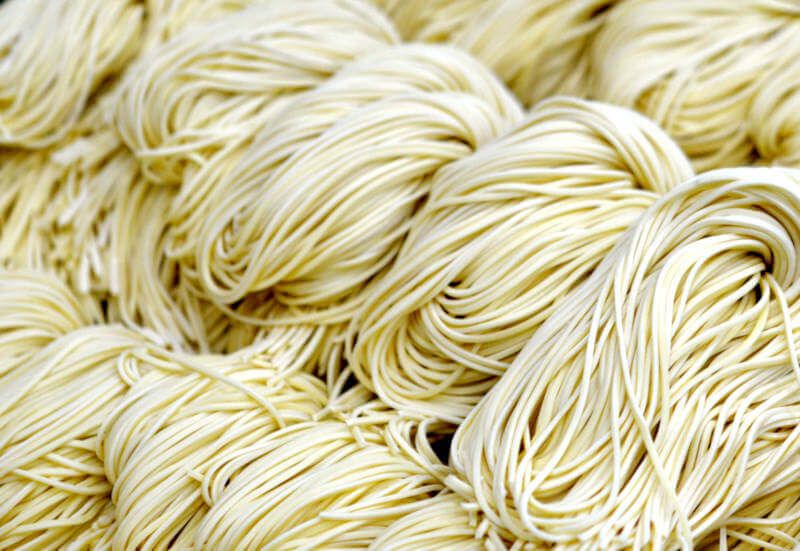
What is Hakata-style tonkotsu?
Hakata is the name of a city in Fukuoka prefecture in Japan, and this city is famous for a variety of distinctive cuisines that keep attracting tourists from other parts of Japan. Ramen is one of them.
There are many variations of Hakata tonkotsu ramen among different ramen specialty shops, but the dish features cloudy soup that is made of pork bones with collagen dissolved to have emulsified*. The seasoning of the soup is mainly salt or shio-tare, which is transparent. So the soup color is white.
(*emulsification happens when an oil and water or water-based liquid like egg yolk are combined and processed in a certain way like stirring and agitation. It becomes cloudy and creamy.)
This soup is usually high in density, and soup viscosity varies from shop to shop. Noodles coupled with this soup are very thin and hard noodles. Because the noodles are thin, they get soft fast in hot soup. This is one of the reasons that the ramen specialty shops encourage customers to order additional portions of noodles (after finishing the first serving of noodles, another serving is served and put in the same soup). It is called "kaedama". Another thing that's unique about Hakata-style tonkotsu ramen is the shop lets you order the doneness of noodles. Depending on the shop, you can choose it on the scale of five. (from hardest to softest)
Tonkotsu ramen in general vary dramatically in the types of tare (seasoning) used, parts of pork bones used, density of soup, and noodles. For example, "Nagahama Ramen" offers the same type of noodles, but the soup is light in density. You can almost drink it all. Or, "Kumamoto Ramen" uses thick noodles and the soup is made not only from pork bones but also from chicken carcasses, which make the soup taste milder than Hakata-tonkotsu, which uses only pork bones in the soup.
There are so many variations of tonkotsu ramen. Basically we can call any soup that uses pork bones as the main ingredients "tonkotsu" soup.
What would you need to make your own Hakata tonkotsu ramen from scratch?

First, choose the density of your soup. Because the soup basically needs to be emulsified (cloudy), you'd definitely need a high-powered cooking equipment (especially for commercial usage). By cooking the stock (pork bones + water + some ingredients that release collagen) at high heat for long hours, the stock gets emulsified. And depending on the soup density you need, you may want to put in extra hours in cooking. The higher the soup density, the bigger the stockpot you want, depending on the quantity you want. So you need a big stockpot and high-powered heating equipment.
Ingredients are also important. And you want fresh pork bones. There are other ingredients like garlic and white peppers, depending on what kind of Hakata tonkotsu ramen you want to make. As a source of collagen, you may want some pork trotters as well.
Cooking the soup may also need long hours, but again this would depend on the density you'd want in your soup.
Hakata tonkotsu noodles

Noodles for Hakata tonkotsu ramen are one of a kind. Though there are many types of noodles around the world, this kind of noodles is rare. First of all, its hydration is extremely low. The dough before being processed is almost like moist flour. The dough is dry and hard. To process this kind of dough, we wouldn't be able to make them by hand but use a machine. But a regular pasta machine cannot process it well because the rollers are too small. That is why noodle machines, specially designed for this type of noodles, called "low hydration noodles" were born. These machines have big rollers that can apply high pressure on the dough to form into sheets. And they can turn the sheets into the famous noodles. The texture is quite unique. They are hard and springy. But as they are thin, the noodle texture or sensation biting are pleasurable. Because of the small size, noodles tend to get soft fast in hot soup. We usually use such ingredients as gluten and egg white to help them retain the texture longer.

Perfect match of soup and noodles
With the soup made by cooking fresh pork bones for long hours and noodles made using a special noodle machine, when combining the soup and noodles, it is a perfect match. The unique taste and flavors are something that you cannot forget and linger in your head for a while. And whenever you hear the name Hakata, you'd remember the bowl you had some time ago.
Would you want to create your own bowl of Hakata tonkotsu ramen? Here's a good place to start as you can learn every aspect of it.
Start your ramen journey here
You can register for our Yamato Noodle School Online for free of charge and access to many resources that are exclusive to those who are registered. Sign up TODAY by clicking the button below.
Write your awesome label here.
Write your awesome label here.
Start your full RAMEN Training TODAY
Pro Ramen Complete Basic Course is now available. You can learn how to make your own craft ramen from scratch today at your own pace, anytime, and anywhere in the world.

